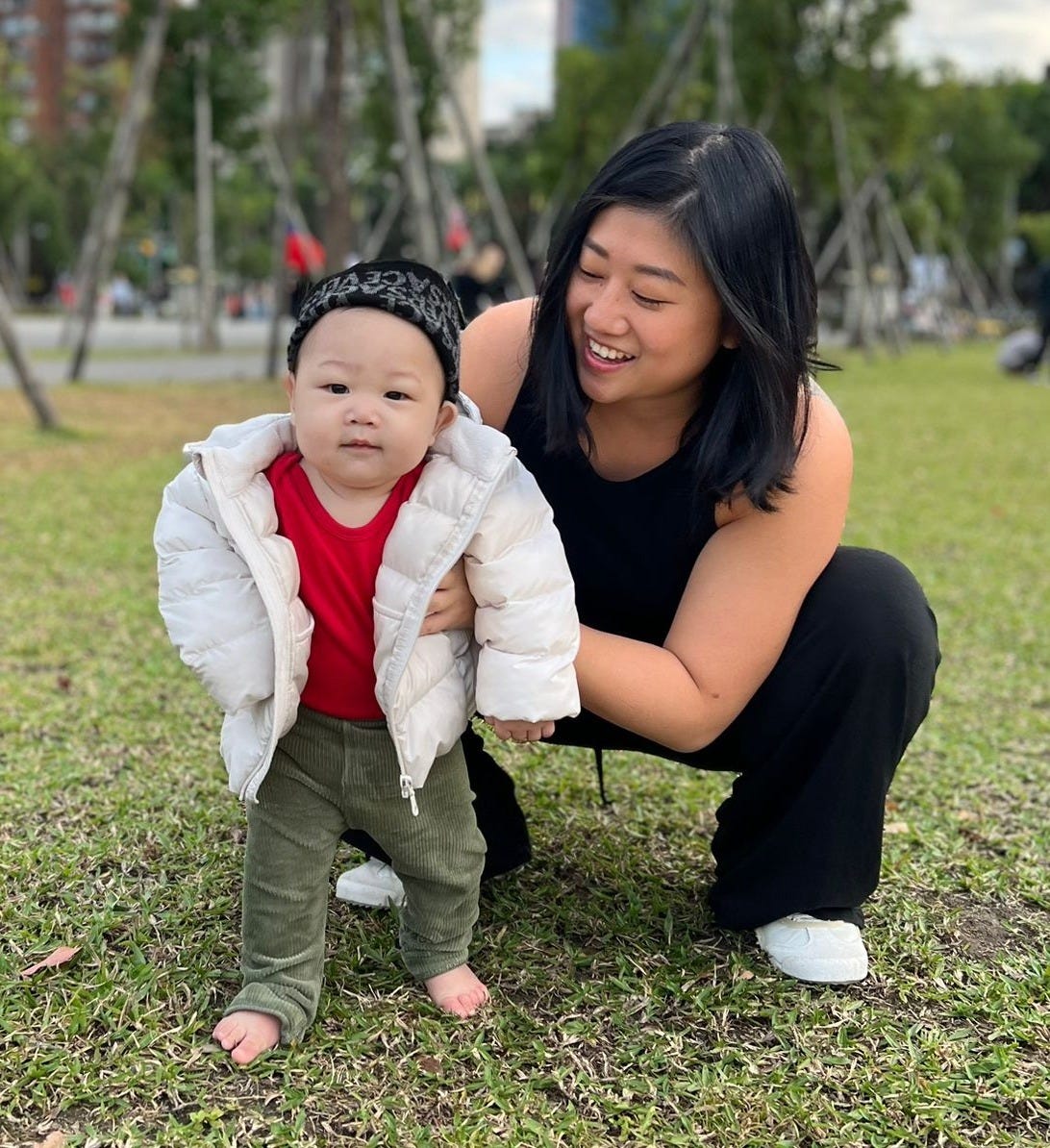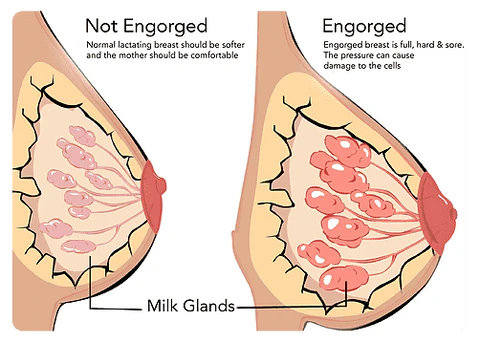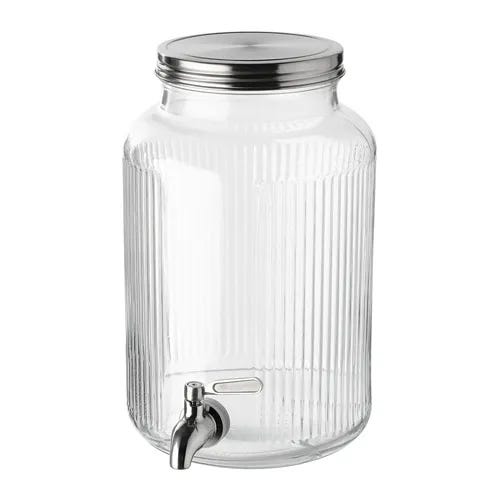Milkonomics (ii)
the first week of breastfeeding while recovering from giving birth was...hellish
For part ii, I will talk about my first week learning how to breastfeed while recovering, including:
The first day of Lyor’s life;
The first week learning about breastfeeding;
Two kinds of physical pain when breastfeeding;
Common breastfeeding “advice”;
How to produce more breast milk;
How to produce nutritious breast milk;
Factors that negatively impact breast milk;
How babies eat.
1. The first day of Lyor’s life and the start of breastfeeding 💉
Jack and I had read in advance that breastfeeding within the first hour of the baby’s life is great for the baby’s health and also for the mother’s body to start learning how to product breast milk, so I was eager to get started as soon as possible1. I had been sleeping for a while and had missed the early initiation of breastfeeding which is why I spent so long arguing with the nurses to let me breastfeed Lyor once I woke up2.
Because Lyor’s mouth was so small and he didn’t know how to use it properly, and because I also didn’t have much milk at the beginning, I started off using a needle-less syringe and had to suction out a few droplets of milk from my breasts and feed it into Lyor’s mouth every 2 hours. This seemed worrying at the time because there was so little milk, but later on, I was able to produce a lot, so looking back now it was actually a helpful process to get things going.
2. The first week of recovery while learning to breastfeed, pump, and make formula 🤱
Due to the fact that I was still recovering from postpartum hemorrhage while having to breastfeed every 2 hours, I started feeling pretty delirious on the second day so I decided to alternate between breastfeeding and introducing formula to Lyor to get more rest.
On the first day, I was only able to get a few droplets of milk each feeding, but by the third day, my breasts started to get really full. I didn’t start pumping although I should have, because I was given misleading information by one of the nurses3, but basically as long as the milk is leaking out of your breasts without prompting, you can start pumping.
To store and use pumped breast milk, you can follow the rule of 3s:
3 hours in room temperature;
3 days in the fridge;
3 months in the freezer.
It’s important to label the pumped milk with both the date and the time because daytime breast milk will contain cortisol from the mother’s body, which promotes alertness, and nighttime breast milk will contain melatonin, which promotes sleepiness. The human body is amazing!
To know when to feed your baby, newborns will give a few signals they are hungry before they start crying. We tried not to wait until Lyor was crying because that’s usually when babies are really distressed and in pain. Some common signs to look out for that they are hungry:
Smacking their lips;
Licking their lips or sticking their tongue out;
Putting their hands or fingers in their mouths.
The only upside to being bedridden the first week is that in order for Lyor to feed from me, he had to be laying on his stomach and I think it trained his neck really fast to be able to lift up his head. Silver linings, amirite?
3. Breastfeeding can be physically painful in two different ways 🤕
The first kind of pain, which I experienced more of, was chapped and raw nipples:
Although babies are born with a natural instinct to suckle, their mouths are very small and they don’t really know how to get the milk to flow out at the beginning by using their tongue. That’s why nipples become raw because babies are just sucking as hard as possible and they don’t have much of a technique;
This is another reason I alternated between bottle feeding and breastfeeding so that I could heal because sometimes my nipples would start bleeding and I didn’t want it getting into Lyor’s mouth;
I found that for myself, pumping could maintain the current milk supply, but I couldn’t produce more milk over time without Lyor feeding directly from me, so pumping is a good temporary break from the pain but I needed to have Lyor breastfeed from me to keep up with his growth and appetite;
Nipple oil, nipple cream, and silver cups4 help soothed the pain, and over some time, it does get a lot easier.
The second kind of pain I experienced early on was when my breasts became clogged with milk and it got “stuck” in my breasts:
This happened when I ate too much fatty or oily foods (even healthier ones like olive oil) and it feels like a severe cramp with shooting bouts of pain. It’s as painful as raw nipples but in a different way, and it was easier for me to avoid this pain as long as I controlled what I ate and fed Lyor regularly so the milk doesn’t clog up;
Pumping helps to release it too, and I also take Lecithin supplements every 4 hours or when I can, which unclogs the milk. This was very effective for me and I highly recommend taking Lecithin5.
A lot of people find a lactation specialist to help with breastfeeding and to overcome the pain, and if you can afford one6, definitely reach out if you’re struggling. I’ve heard good things about working with lactation specialists but I didn’t personally look for one. Eventually, with literal blood, sweat, and tears, I got better at it7.
4. Breastfeeding “recommendations” from “experts” 🥴
There are many online resources and globally-recognized organizations such as the CDC and the WHO that recommend mothers exclusively breastfeed (EBF), which means no formula, and they recommend it for at least 6 months and all the way past 2 years old (while introducing solids at the same time after 6 months).
This is a difficult timeline to reach because although it seems like a “natural” act, breastfeeding is not that easy to do in our structured, human world we’ve built. There are a lot of factors that go into producing nutritious breast milk and also daily factors that easily reduce the amount of breast milk produced, which I will explain below.
In general though, there’s too much shame for women and mothers, so while breast milk does give all the nutrition a baby needs for at least 6 months, formula should be a completely acceptable alternative if breastfeeding is not an option for whatever reason. In fact, many of us grew up on formula, and Jack and I used formula alongside breast milk to feed Lyor, because sometimes I felt that I wasn’t able to produce enough milk for him naturally, and he currently seems to be healthy and strong so I have no regrets.
5. Increasing the supply (amount) of my breast milk 📈
Drinking enough liquids was really important for me to be able to have enough breast milk to feed Lyor, who seemed like he had an endless appetite. I was advised by a nutritionist to drink 4L of water a day! I ended up buying IKEA’s water carafe, which can hold up to 5L of water, and it was like some evil sport trying to finish so much water in a 24-hour period, especially given that I hadn’t started working out yet.
In Taiwanese culture, drinking soup with protein (e.g. chicken soup) is also extremely beneficial as it helps with both the supply as well as the nutritional value of the breast milk. At the 月子中心 postpartum center I stayed at, they gave me soup 4x / day and also large jugs of non-caffeinated hot tea 2x / day (e.g. black bean tea or malt tea). Those really helped with my breast milk supply, even though it really was overwhelming to consume all the liquids on top of the food I had to eat too.
Some people naturally can create a lot of breast milk, but for those that can’t, like me, drinking tons of liquids was helpful.
6. Improving the quality (nutrition) of my breast milk 🏅
Eating a lot of protein really helped with ensuring there was enough nutrition for Lyor. That’s why bone broths are great because you can get the best of both worlds (nutrition + amount). I also snacked on granola cereal since it’s high in protein, and you can look up some other protein-rich foods that you can eat.
After protein, it’s important to eat a good amount of veggies and also a little bit of carbs. Jack is a great cook but his work was very demanding, so we found a chef through an online platform who could come to our place once a week and cook multiple meals for us in one go8.
Just to remind you again, eating fatty or oily foods can cause your breast milk to clog up, so try to avoid those during the months you’re breastfeeding because it will be quite painful!
7. Being stressed affects how much breast milk you can produce 😢
Stress is one of the biggest killers of breast milk. It’s likely that we evolved where, when we used to encounter stressful situations like being under attack, our bodies would halt production of breast milk so we can conserve our energy to protect ourselves and our babies since it takes so much energy and calories to create breast milk in the mother’s body, around the same amount needed to run ~10km per day9. This is another reason why it’s important to eat enough protein.
For me, that meant I needed enough rest and sleep as these can significantly impact my mental health and moods due to my schizophrenia. This is probably the hardest part to manage because it’s really hard not to feel stressed out in the first few months due to:
the lack of sleep from Lyor’s feeding schedule, which was happening every 2-3 hours if you’re breastfeeding (+1 hour difference if you’re formula-feeding);
anxiety over SIDS (sudden infant death syndrome)10, which is the leading cause of death of babies under 1 years old in developed nations and it usually occurs at night while everyone is sleeping;
the huge learning curve of taking care of a baby, because even if you read all the books and talk to a lot of people, you cannot be prepared to know what it’s like. Imagine trying to learn how to swim without getting into the water;
very little care from our institutions and society, to the point where Jack chose to leave his job so he could focus on being a new father since his co-workers were unsupportive of his needs11.
Each family has their own unique challenges too, so combined with all the above, it really is hard not to feel stressed out with a baby.
For me, to de-stress, I only really had time to do my skin routine in the mornings and evenings, which did help. I also read my Kindle while I would breastfeed. Some light workouts12 and listening to meditation apps13 also helped me. However, I still felt stressed most of the time, so there isn’t a great solution, but do trust that things get slightly more manageable as you get better at being a parent!
8. What we learned about Lyor’s eating habits
There’s a lot of content out there that tells you how much and how often to feed a baby, so I won’t go into too much detail here about the calculations14 and so on, but I wanted to share some context around a baby’s eating habits:
One of the reasons babies need to eat so frequently at the beginning of their lives is because their stomachs are so small that they can only eat a little bit in one go15 so they need to eat often to reach their daily nutrition needs;
For breastfeeding, Lyor needed to be fed every 2 hours on average for the first month, including through the night, and even though many resources will give you this expectation beforehand, it was still shocking how difficult and unattainable this goal was for me;
Breast milk is easier to digest than formula, which is why feedings are more frequent when breastfeeding. Breast milk is also completed digested by the baby’s body, so they actually poop less frequently when drinking breast milk, and they don’t need to be burped as often since their bodies can digest the milk easily;
We don’t follow a set schedule feeding Lyor every X hours and instead try to follow his hunger cues and think about how he’s eating overall in the day16;
Babies can get all their necessary nutrition needs from milk for the first 6 months of their lives, which is why it’s not recommended to feed them other foods or liquids until then.
It’s all a learning curve for sure, but once we spent enough time with Lyor, we started to really understand how to best respond to his eating schedule.

Alright, that’s the end of part (ii); thanks for reading so far!
If you’re curious about what we learned each month taking care of Lyor till I stopped breastfeeding, check out part (iii)
Breastfeeding is very healthy as early introduction to breast milk has no correlation to kids getting diabetes or obese in the future.
One of my biggest worries was that I wasn’t going to be able to produce enough breast milk, not necessarily because my breasts are small (which doesn’t affect breast milk supply), but because I had heard from many people I knew that it wasn’t easy to breastfeed.
I bought these silver cups on Amazon and they really help with soothing the pain, and they are much more effective, less wasteful, and more comfortable than bra pads in limiting the milk flow.
I use this brand of Lecithin supplements that you can buy on Momo in Taiwan. It’s not dangerous to take a lot in one day.
Lactation specialists are expensive! A friend in Taiwan paid over NT$10K (US$300+) for one to help her.
I’ve had a friend who tried for 3 months and it was painful the entire time so she decided to switch to formula, and she said it made bonding so much better when there was no pain involved, which I totally agree with.
Her name is Trista (IG: @tristas__cooking_philosophy) and she does both Asian and Western dishes, which is a big reason we chose her since many other chefs only do Asian dishes. She can do twice a week too if you want all meals throughout the week to be home-cooked.
It takes an additional ~500 calories a day for a regular-sized woman to breastfeed and an additional 600+ calories to run a 10km per day, according to Perplexity.
SIDS is the leading cause of death of babies under 1 years old in developed nations and it usually occurs at night while everyone is sleeping.
Taiwan is still much more traditional in its mindset when it comes to gender roles, with men only getting 7 days of paid paternity leave, while women get 8 weeks of paid maternity leave.
I started with jogging and working out helped me sleep better as well.
I paid for Headspace first, which was ok at the beginning, but I found it too repetitive so I switched to Insight Timer which I think has much more options, even on the free plan.
We used this calculator was when we first started formula feeding.
This is why water isn’t recommended for babies because there’s not a lot of nutrition in water and their stomachs need to be taking in as much nutrition from milk as possible. Also, formula and breast milk is mostly water so they’re already getting their water intake from normal feeding.
This was one thing I didn’t like about staying at a 月子中心 postpartum center because they use a set schedule to feed the babies (e.g. every 4 hours) and although it’s understandable why, since they have multiple babies to take care of and have limited nurses, it sacrifices the baby’s natural eating habits for the convenience of the staff.





